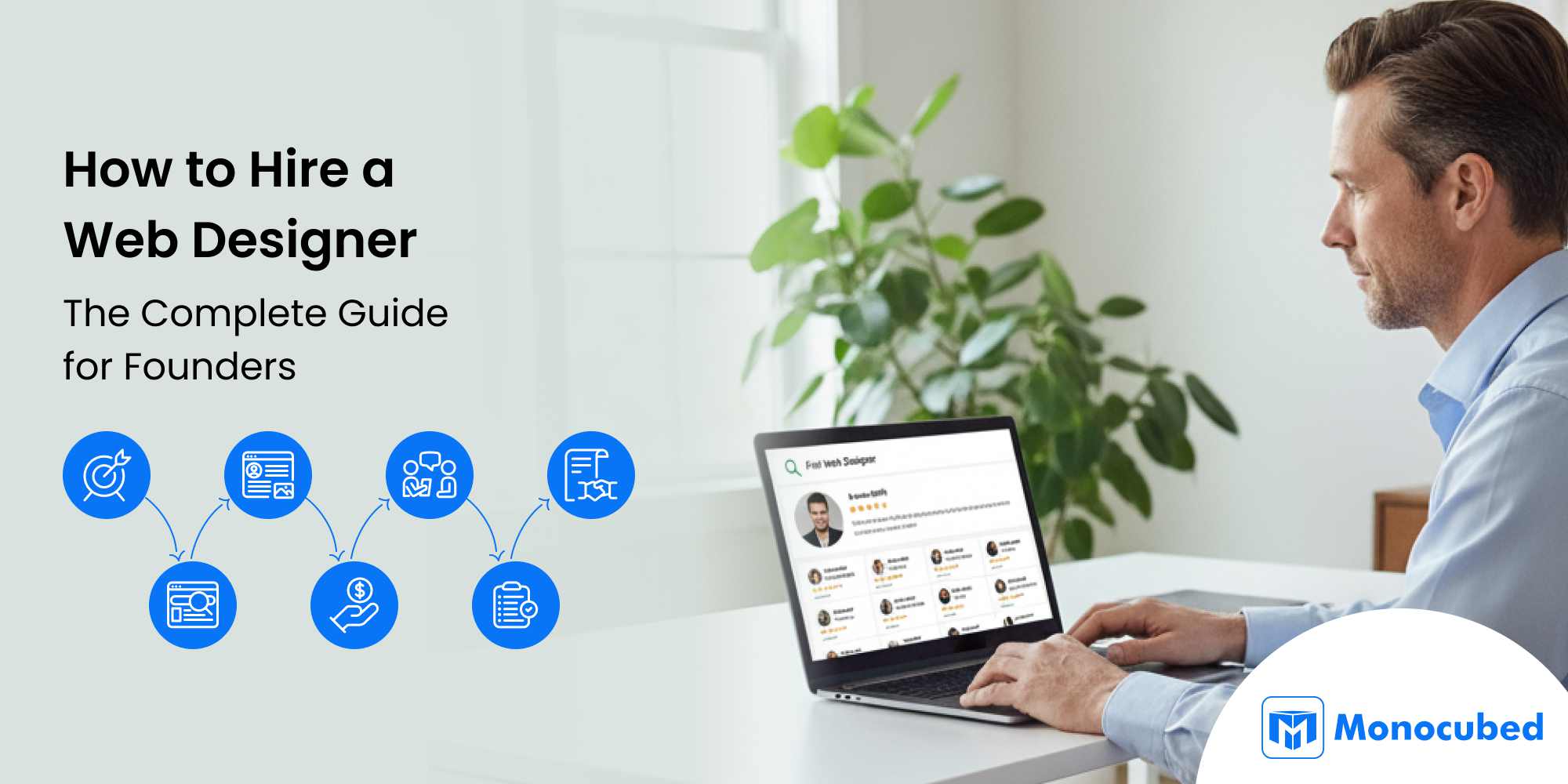Your website is your brand’s first impression. In fact, 94% of the time, users form their opinion about a website based on its visual design, according to CXL research. Poor website design causes businesses to lose potential revenue, while modern, user-friendly websites can significantly boost conversions.
Whether you’re launching a new brand or redesigning an outdated site, hiring the right web designer can define your online success. At Monocubed, we offer web design services that have helped hundreds of clients to transform their underperforming website into a business growth engine.
With years of experience, we also find that the process of hiring a website designer can be challenging for founders and business owners.
So, how do you find someone who understands your vision, audience, and technical goals?
That’s exactly why we’ve created a complete guide with our expertise. This guide will help you confidently navigate how to hire a website designer.
By the end of this blog, you’ll learn:
- Step-by-step how to hire a website designer
- What skills to look for
- How to evaluate portfolios
- Determine the cost of hiring a web designer
Let’s learn how to hire the best web designer for your upcoming project.
Table of Contents
- What to Consider When Hiring a Web Designer
- 7-Steps to Follow to Find and Hire a Website Designer
- Where to Find Web Designers Online
- 5 Red Flags to Watch Out for When Hiring a Website Designer
- 4 Tips to Follow After Hiring a Web Designer for Smooth Collaboration
- Hire the Best Web Designer from Monocubed
- Frequently Asked Questions About Hiring a Web Designer
What to Consider When Hiring a Web Designer
When you’re ready to hire a website designer, the key to success lies in choosing someone who doesn’t just create pretty layouts but builds a website that works hard for your brand.
A great designer combines artistry with strategy and understanding how design decisions impact user experience. To hire the best web designers, consider the following factors proven by Monocubed, a top-rated web development company.
-
Assess their portfolio and experience
A designer’s portfolio is your window into their creativity, skill, and problem-solving ability. Before signing any contract, explore their past projects in depth. Look for diversity in style, functionality, and purpose.
Examine whether their websites load quickly, look seamless across devices, and guide users naturally toward key actions.
For example: If you’re hiring a website designer for an e-commerce project, prioritize professionals who have experience designing ecommerce websites or working with your preferred platform, like Shopify, WooCommerce, or WordPress.
-
Evaluate their skills, tools, and workflow
A professional web designer blends creativity with technical expertise. Beyond having a good eye for design, they should be comfortable with key web technologies such as HTML, CSS, and JavaScript, and be proficient in leading content management systems (CMS) like WordPress, Webflow, or Shopify.
You’ll also want to ensure they use modern design tools, such as Figma, Adobe XD, or Canva Pro to build wireframes and prototypes efficiently. Designers who understand SEO principles, page speed optimization, and responsive design will deliver a stronger final product that ranks well and performs beautifully across all devices.
Ask about their website design and development process and workflow and how they gather requirements, develop initial concepts, collect feedback, and implement revisions. Clear stages and timelines signal professionalism and help you understand exactly what to expect at every step of your web design journey.
-
Gauge communication, collaboration, and professionalism
When hiring a website designer, communication can make or break the project. You want someone who listens carefully, explains their creative decisions clearly, and collaborates with transparency.
Check client testimonials and online reviews to gauge their reliability, responsiveness, and ability to meet deadlines. During your initial calls, notice whether they ask thoughtful questions about your goals, brand, and target audience. This reflects genuine engagement and strategic thinking.
Also, inquire about their project management style: How do they share updates? What tools do they use for feedback and revisions?
Great web designers guide, advise, and communicate effectively from kickoff to launch.
-
Discuss project budget, contracts, and long-term support
Budget clarity is essential when you’re ready to hire a professional web designer. Be upfront about your expectations and ensure their pricing structure aligns with your goals.
Request a detailed proposal and contract that clearly outlines project scope, deliverables, payment milestones, timelines, and revision limits. Equally important, make sure ownership rights of your website design and assets are clearly defined and your business should fully own the final product.
Websites are living entities that evolve with your brand. Ask whether the designer offers ongoing website maintenance, technical support, or SEO optimization after launch. Many top designers also provide content creation or branding services, which can make post-launch updates more cohesive and efficient.
Take a Shortcut – Hire the Best Web Designer from Monocubed
Work with a pre-vetted team of web developers and designers that listens, collaborates, and keeps you informed every step. Choose what’s best for your business.
7-Steps to Follow to Find and Hire a Website Designer
Finding the right web designer can feel overwhelming but it doesn’t have to be. This step-by-step guide makes your job of “how to choose a website designer” way easier. Follow these simple steps who bring your vision to life and drive results for your business.
Step 1: Define your goals before you hire
Before reviewing portfolios or contacting designers, it’s critical to clarify your project goals:
- What is the primary purpose of your website? (E-commerce, lead generation, branding, SaaS platform)
- Who is your target audience?
- What are their pain points?
- What features and integrations are essential? (CMS, payment systems, dashboards)
- How will success be measured? (Traffic, conversions, revenue)
Defining these early ensures you hire a designer aligned with your vision rather than just aesthetics.
Step 2: Start your search the smart way
The internet is your best friend here. Use Google and search for terms like “hire a web designer near me” or “best WordPress designers.”
Suppose you’re looking for a website designer or developers from a professional talent pool. In that case, Monocubed offers a pre-vetted team of web designers who understand your specific audience, business goals, and the latest web trends. They adhere to the industry-specific compliance and accessibility standards, whether its website design development for healthcare or web application design for fintech.
Step 3: Dive deep into their portfolio
A portfolio is a proof of skill. Review their past projects carefully. Ask yourself:
- Does their style match your brand’s vibe?
- Are their websites fast, easy to navigate, and responsive on phones and tablets?
- Have they created sites similar to yours? (For example, e-commerce, blogs, or service sites)
Visiting live sites rather than just screenshots gives you the full experience.
Also, prioritize website and web app designers with experience in your industry, especially if you want to hire e-commerce website designers who understand sales funnels, build mobile-first design, checkout UX, and product presentation.
At Monocubed, we invite you to explore our portfolio, where you can see firsthand how we blend creative design with robust functionality. Our projects range from custom e-commerce platforms to business automation web apps, all optimized for user experience and conversion.
Step 4: Set a realistic budget
The cost to hire a website designer varies widely. Here’s a breakdown based on research and industry standards :
| Type of Designer | Cost Range | Description |
|---|---|---|
| Freelance Web Designer | $500–$5,000 per project | Suitable for small businesses or landing pages |
| Design Agency | $5,000–$15,000+ | Ideal for complex, multi-page, and e-commerce sites |
| Hourly Rate | $30–$120/hr | Depends on skill level, complexity, and scope |
In general, expect to invest about $6,000–$10,000 for a professionally designed website including setup, custom design, content structure, and training.
Big e-commerce projects or enterprise websites could exceed $15,000 depending on plugins, integrations, and data dashboards.
Step 5: Interview and compare prospects
Once you shortlist candidates, schedule consultations to assess communication, technical, and creative alignment. Use structured questions such as:
- What is your design process from concept to launch?
- How will the website align with SEO and performance goals?
- What specific metrics define a successful web design for you?
- How do you handle revisions, deadlines, and ongoing maintenance?
Good communication helps you choose the right website designer who understands your business workflow and aligns with your needs.
At Monocubed, we emphasize transparency and collaboration during these consultations. Our clients appreciate how we tailor our design process to their unique business goals, integrating SEO and user experience strategies seamlessly.
Additionally, we encourage open dialogue about expectations and challenges, ensuring the final product is not only visually stunning but also performance-driven and easy to maintain. This approach has consistently delivered satisfaction and measurable growth for our partners.
Step 6: Check their references
When checking references for a web designer, it’s vital to ask targeted questions that uncover the quality of their work, professionalism, and ability to deliver on promises.
Focus your questions on:
- Performance and reliability: Did the designer meet deadlines and stay within scope?
- Quality of work: Did the projects lead to measurable improvements, like increased traffic or conversions?
- Communication: Was the designer clear, responsive, and easy to work with?
- Problem-solving: How did the designer handle challenges or revisions?
- Overall satisfaction: Would the previous client rehire them? Why or why not?
As a leading website design and development company, we also recommend exploring online reviews and testimonials to complement your reference checks, providing a broader perspective.
Step 7: Seal the deal with a clear contract
Once you decide on your web designer, putting everything in writing is non-negotiable. A well-drafted contract protects both you and the designer by clarifying expectations and responsibilities upfront.
Your contract should include:
- Scope of work: Clearly define deliverables, project boundaries, and what’s excluded to prevent scope creep.
- Timeline: Outline deadlines for each phase, including design drafts, revisions, and final launch.
- Costs and payment schedule: Specify total price, payment milestones, and refund policies.
- Ownership and intellectual property: Confirm that you own the finished product and clarify any rights the designer retains, like design system elements or portfolio credits.
- Revisions and feedback process: Set limits on revision rounds and approval workflows.
- Ongoing support: Detail maintenance options and post-launch support responsibilities.
- Termination clause: Explain how either party can end the contract and the associated consequences.
We deliver contracts that are easy to understand, aligning expectations from day one. Regular client check-ins and ongoing support beyond launch are part of our commitment to building lasting, successful partnerships.
A clear, detailed contract lays the foundation for a smooth project and better communication throughout the web development lifecycle.
Hire the Right Web Designer Without the Headache
Follow our proven steps to find a designer who truly gets your vision, align with your workflow, and provide mobile-first, highly interactive website designs.
Where to Find Web Designers Online
Beyond Google and freelance platforms, explore these channels:
- Localwebsite development agencies: Ideal for face-to-face collaboration and faster communication, especially if you prefer hands-on project management.
- Professional directories: Sites like Clutch, UpCity, and DesignRush offer curated lists of vetted agencies with detailed reviews.
- LinkedIn and Dribbble: Many web app designers actively showcase their portfolios and share professional updates on these platforms.
- Referrals: Ask trusted colleagues or business peers for recommendations, they often lead to reliable, proven talent.
- Community forums and groups: Platforms like Reddit’s r/web_design and relevant Facebook groups can connect you to high-quality freelancers and agencies.
Among these options, Monocubed stands out as a trusted web development agency known for its industry expertise in web design and development, AI-powered solutions, and a client-focused approach.
While hiring a website designer, you might miss some of the red flags that can turn into costly mistakes for your business. In the next section, let’s learn about the key red flags to look for while looking for web designers online.
5 Red Flags to Watch Out for When Hiring a Website Designer
Choosing the right web designer is critical, but even skilled professionals may not be a perfect fit for your project. To steer clear of costly mistakes, watch for these warning signs:
- Vague timeline or pricing structure: If a designer can’t provide a clear project timeline or detailed website design cost breakdown, it’s a red flag that may lead to unexpected delays and budget overruns. Transparency here is key.
- Over-promising with unrealistic deadlines: Beware of anyone claiming to deliver a complex website in record time or guaranteeing instant success—quality web design is an iterative process requiring proper planning.
- Lack of concrete references or case studies: A reputable designer should provide real-world examples and client testimonials proving their expertise and reliability.
- Unfamiliarity with mobile-first and accessibility standards: With the majority of users on mobile and increasing emphasis on accessibility, ignoring these is a sign of outdated practices.
- Poor communication or responsiveness: Slow replies, unclear explanations, or avoiding essential questions signal potential collaboration issues.
Always request a written scope of work outlining deliverables, deadlines, payment milestones, and post-launch support before development begins. This protects both parties and sets clear expectations.
Once you hire a website designer with no red flags mentioned above, the next step is to set up smooth communication and collaboration. It helps you work smoothly with an outsource web development team or web designers.
4 Tips to Follow After Hiring a Web Designer for Smooth Collaboration
Hiring a web designer is just the beginning of a successful website project. The real key lies in building a strong collaborative relationship that ensures smooth progress and delivers outstanding results. Here are actionable best practices to guide your project from concept to launch:
-
Set Clear Milestones
Divide the project into manageable phases such as wireframing, design concept, development, testing, and handover. Each phase should include built-in review checkpoints and feedback sessions to keep the project on track, avoid surprises, and allow timely course corrections. This phased approach keeps everyone aligned and accountable.
-
Define Ownership
Establish upfront who owns the website assets after completion, including brand elements, content, and code. You want to ensure your company retains full legal ownership and control to avoid future complications or dependency on the designer.
-
Schedule Regular Check-Ins
Whether virtual or in-person, weekly or biweekly meetings create a communication rhythm that keeps all stakeholders updated and engaged. This ongoing dialogue helps identify challenges early, fosters transparency, and boosts collaboration.
-
Encourage Two-Way Feedback
Great design evolves through open dialogue. Encourage clear, constructive feedback from your team, but also give your designer room for creative freedom and innovation. This two-way conversation helps refine the website into a unique, high-functioning asset that meets user needs and business goals.
Hire the Best Web Designer from Monocubed
Hiring the right web designer is more than just creating a visually appealing website. It’s a part of the process to build a platform that grows your business, engages your audience, and drives conversions.
Whether you need a landing page website designer or a specialized e-commerce website designer, choosing the right partner ensures your investment delivers measurable results.
Our 20+ expert designers and experienced web developers combine deep industry knowledge with the latest technologies like React.js, Next.js, Vue.js, Angular, and headless CMS to craft websites that are modern, scalable, and high-performing.
By partnering with us, you gain:
- A website that captures your brand vision and resonates with your audience
- Seamless collaboration and transparent pricing
- AI-powered innovation for faster, smarter results
- Ongoing support to keep your site optimized and future-ready
With Monocubed, you get a strategic digital asset that drives growth, builds trust, and sets your business apart.
Skip the Hustle Now – Get a Vetted Web Designers for Your Project
Save time and avoid trial-and-error by working with pre-screened, expert web designers from our web design company who deliver results.
Frequently Asked Questions About Hiring a Web Designer
-
How much does it cost to hire a web designer?
The cost to hire a web designer ranges from $500 to over $50,000, depending on project complexity and the designer’s experience. A simple five-page site may cost $500–$2,000, while complex e-commerce or custom websites can reach $5,000–$25,000+.
-
How long does it take to design and develop a website?
The time it takes to design and develop a website can range from a few hours to over a year, depending on factors like complexity, customization, and resources. A simple, template-based site for a personal blog or small business can be launched in a matter of days or weeks.
-
How much should I budget when hiring a professional web designer?
Budgeting for a web designer depends on your project’s size and complexity. A simple static website typically costs $500–$2,000, while a large, custom site with advanced features can range from $10,000 to $50,000+. Freelancers often charge $30–$150+ per hour. Costs are influenced by project scope, designer experience, and customization level.
 By Yuvrajsinh Vaghela
By Yuvrajsinh Vaghela


